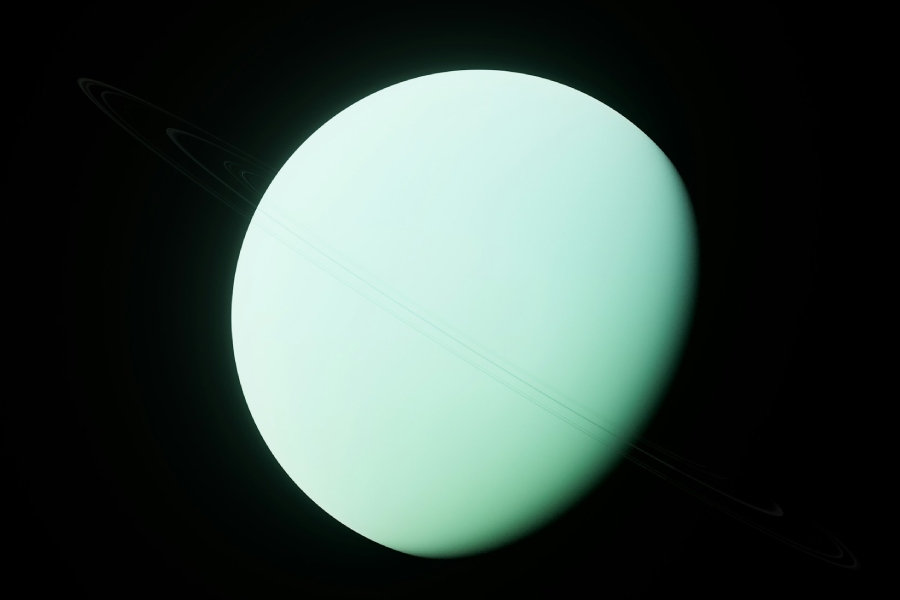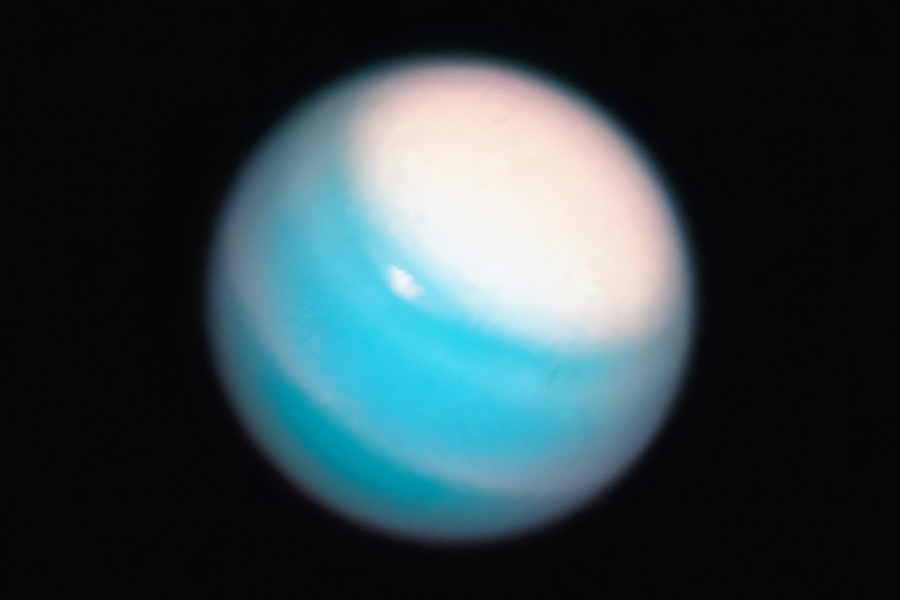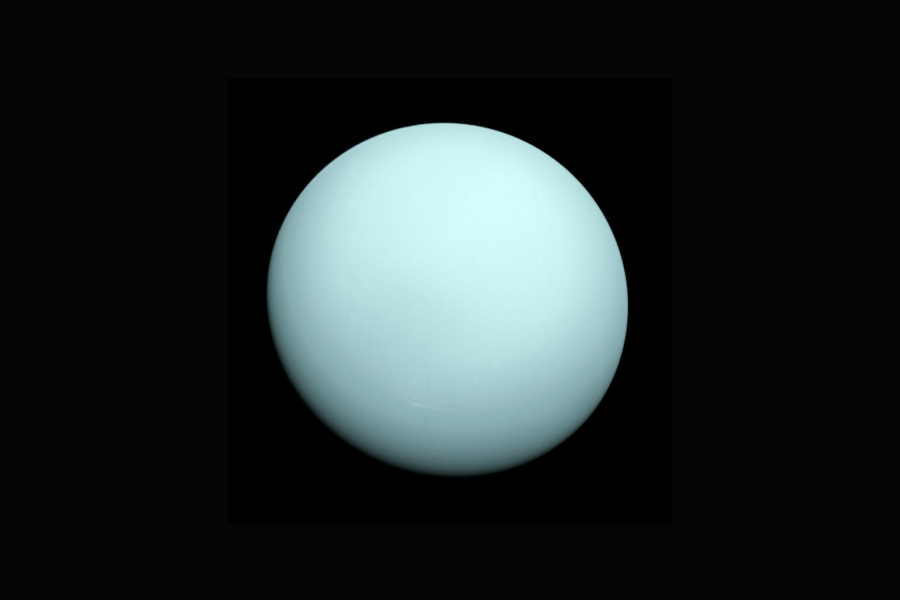Out in the far reaches of the Solar System orbits a planet shrouded in mystery – Uranus. The icy seventh planet from the Sun has an axis oddly tilted sideway at 97 degrees, with seasons that last over two decades long. But another point of fascination is Uranus’ size. So, how big is Uranus? What are the true dimensions of this distant, chilly world?
We will explore how Uranus measures up in terms of diameter, volume, and mass when compared to Earth and other planetary heavyweights. Its gaseous layers contain some clues.
While Uranus boasts significant width, its mass tells a different story. Determining a planet’s bulk offers insights into its composition and internal structure. In the case of Uranus, the numbers have revealed some surprises underneath the cloud tops.
In this article, we’ll unpack the various measurements of the planet Uranus and what they reveal about its formation and place in the Solar System. The quest to understand this strange orb’s size has uncovered intriguing planetary science.
How Big Is Uranus?
Uranus is a gas giant, which means it’s a huge ball of gas in our solar system. It’s about four times wider than Earth, making it the third-largest planet.
Uranus ranks 7th in the Solar System for diameter and 4th for mass out of eight planets. Neptune is the only planet that Uranus outranks in physical size, according to planetary scientists today. Astronomical measurements place Uranus’ diameter at 31,763 miles across.
Despite its large size and classification as a “gas giant”, Uranus is much lighter than other gas giants, Jupiter and Saturn, because it has a different composition. It has an extensive gaseous atmosphere consisting of hydrogen and helium, and it’s composed mainly of heavier elements and has a much rockier core.

Comparison with Jupiter and Saturn
Jupiter and Saturn form a distinct class of enormous gas planets significantly exceeding Uranus in size and mass. Uranus’ diameter equals only four Earths laid side by side. Saturn could hold roughly nine planet Earths across. Jupiter, as the Solar System’s giant, comprises 11 Earth diameters in its swirling bulk.
Cellular atmospheric layers are also far deeper in these larger planets. Uranus is much smaller despite its giant status compared to these two behemoths.
Understanding Uranus’s Properties
Diameter, circumference, and mass measurements of Uranus
Precise quantification of Uranus’ diameter, circumference, and mass provides insights into the planet’s composition and internal structure.
- Diameter – 31,763 miles across Uranus’ equator based on direct imaging and altimetry observations. Reveals potential layering within the gaseous and icy interior.
- Circumference – Approximately 100,000 miles around Uranus’ equator. Determined by tracking visible cloud features rotating over time. Defines the rapid spin rate.
- Mass – Calculated at 8.68 × 10^25 kilograms from examination of gravitational influences on neighboring Kuiper belt objects and moons of Uranus. Mass indicates a high-density interior likely differentiated into core, mantle, and atmosphere.
Advanced space telescopes and planetary science consortiums gather abundant data on Uranus through multiple measurement methods. By overlapping techniques, highly accurate models of Uranus’s size attributes, including diameter, circumference, and mass, are derived at different degrees of the planet’s depths.
Features and physical attributes of Uranus’ structure
Uranus spins nearly sideways, making for very long summer and winter seasons. The interior is likely more rocky compared to other gas giants. It has powerful winds and complex cloud layers in the atmosphere, and numerous dark spot storms were imaged by probes.
Uranus is believed to be composed of a heavier rocky core, icy mantle, water-ammonia ocean, and gaseous atmosphere layers. Its atmosphere comprises hydrogen, helium, and methane components lending a blue-green tint. Interior fluid layers conceivably enable tilted axes as further study is needed to confirm models.
Process of Measuring Uranus’ Size
Determining Uranus’ equatorial diameter
Multiple methods are used to measure Uranus’ physical proportions. Direct imaging gauges the visible disc diameter, while radio occultations assess the extent of the opaque atmosphere. Altimetry maps the contours of the planetary surface, and gravitational influence betrays the interior mass.
Older telescopic observations had established Uranus to be roughly four times the size of Earth. The Voyager 2 flyby in 1986 ushered in the modern precision measurement era. Since then, observations by advanced space telescopes have enabled the continuous refinement of all size attributes and dimensions.

Calculation of Uranus’ circumference
The latest number for Uranus’ equatorial diameter is 31,763 miles across. Using a geometric formula for the circumference of a sphere: C = 2πR. R = 15,882 miles. Therefore, the calculated circumference of Uranus is ~100,000 miles.
This provides a useful value for comparing Uranus’ size to other planets’ circumferences. Uranus ranks third in the Solar System for total equatorial circumference, outsized only by the larger gas titans Saturn and Jupiter. Calculating the circumference also gives us a baseline for modeling characteristics like the wind speeds in Uranus’ atmosphere.
Comparative Analysis With Other Celestial Bodies
Uranus’ size in comparison to Earth and gas giants
As mentioned above, Uranus’ diameter is over four times wider than Earth’s. Jupiter and Saturn dwarf Uranus with 11 and nine Earth diameter spans, respectively. This places Uranus’ size firmly between terrestrial and jovian classes.
The major differences in planetary scale and mass affect factors like their gravitational forces, atmospheres, temperatures, and more. Uranus struck balance, enabling longer retention of light gasses that escaped smaller planets, but it has insufficient mass for runaway accretion like Jupiter.
Comparative analysis with neighboring ice giants
Neptune edges out Uranus with a slightly wider diameter and greater mass at 17 Earth masses versus 14.5 for Uranus. This makes Neptune marginally denser internally. Both are still classified as twin “ice giants” compared to gas giants.
Modeling formation histories rely partly on tracking size factors over time. Determining evolutionary divergences between the ice giants remains an open area necessitating precise measurements of current states.
Radii Measurement Accuracy
Trying to take Uranus’ measurements presents scientists with a tricky puzzle. This distant ice giant is wrapped in hazy layers of clouds, hiding any solid surface from view. So, how do you size up a world you can’t clearly see?
Astronomers employ clever tools to peer beneath the mystery, such as:
- Special cameras examine atmospheric extent by studying light blocked by Uranus itself
- Radio detectors assess the atmosphere’s reach using similar occultation methods
- Altimeters can provide surface elevations if any solid ground is detectable
Modern spacecraft can gauge Uranus’ diameter within a few kilometers. But with no visible surface for reference under the thick cloud deck, precisely defining this planet’s true shape and size remains challenging at such great distances.
As technology improves, future missions hope to unveil Uranus’ buried secrets, using advanced cameras, altimeters, and other ingenious devices to strip away the obscuring outer layers. Only then will its true dimensions be revealed!

Conclusion
As we conclude our examination of Uranus’ size and dimensions, we come away with an enhanced appreciation that measurements tell a meaningful planetary story beyond mere numerical values.
We’ve seen how Uranus’ four times wider equatorial diameter compared to Earth impacts everything from ring systems to liquid layers below its atmosphere. Hopefully, gaining a multidimensional perspective on the planet has transformed remote statistics.
By examining factors from circumference to composition, we have moved toward perceiving Uranus as a dynamic orb. One with distinct structures tied intimately to its bulk.
As technology enables increasingly refined measurements, the dimensions of Uranus remain a gateway to a deeper understanding of this icy giant. By contextualizing diverse size metrics, we ultimately move closer to grasping Uranus not as an abstract entity defined by data but as a sculpted, layered world in its own right.
In asking how big is Uranus, we are also questioning how to transcend detached statistics toward deeper affinity with alien environments lightyears away. There, we yet find beauty, awe, and connection awaiting.
